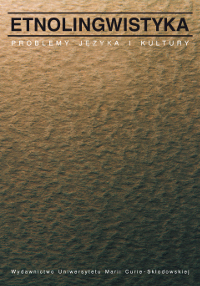KOGNITYWNY OBRAZ GNIEWU WE WSPÓŁCZESNEJ POLSZCZYŹNIE
A COGNITIVE PORTRAIT OF “ANGER” IN CONTEMPORARY POLISH
Author(s): Agnieszka MikołajczukSubject(s): Anthropology, Language studies, Language and Literature Studies, Applied Linguistics, Psycholinguistics, Cognitive linguistics
Published by: Wydawnictwo Naukowe Uniwersytetu Marii Curie-Sklodowskiej
Keywords: the image of ANGER in the modern Polish language; phrasemes; George Lakoff; conceptual metaphors; conceptual metonymies; image schemas; the source of metaphors; aspects of the notion ANGER; GNIEW
Summary/Abstract: The aim of the paper is to establish what concepts and image schemata are utilized by speakers of Polish to understand and talk about anger. The study is based on the material of Polish terms of anger in its various shades (mainly phraseological expressions) as well as patterns of behaviour connected with it. We make use of the concepts and methods proposed by Lakoff (G. Lakoff, 1987, Women, Fire and Dangerous Things. What Categories Reveal About the Mind, Chicago: Chicago Press) in the chapter on the structure of the English concept of ANGER. In the main body of the paper, owing to the delexicalization of some fixed expressions, it has been possible to present the physiological symptoms of anger, “frozen” in language. It has also been possible to reconstruct the metonymies and conceptual metaphors which aid our thinking and talking about anger.The final result of the analysis is the designation of three groups of factors which constitute the cognitive portrait of anger in Polish. These are:1. Simple image schemata: EQUILIBB.IUM, A CONTAINER, MOVEMENT (UP/ DOWN).2. Concepts which serve as the key to understanding anger (the source of metaphors):PHYSICAL PAIN, WEIGIIT (7BURDEN?), BODILY ILLNESS, RABIES, MADNESS,POISONING, STOR.MY WEATHER, DANGEROUS ANIMAL, ENEMY, DEVIL, TRAP, PRISON, SEA, FIRE, HOT LIQUID.3. Various aspects of the concept of anger: the cause, the causer and the object of the emotion, the recipient, the subject, the emotion itself and its evaluation, the degree of its intensiveness, its depth and permanence, the possibilty of bringing it under control, and its symptoms.
Journal: Etnolingwistyka. Problemy Języka I Kultury
- Issue Year: 8/1996
- Issue No: 8
- Page Range: 131-145
- Page Count: 15
- Language: Polish

